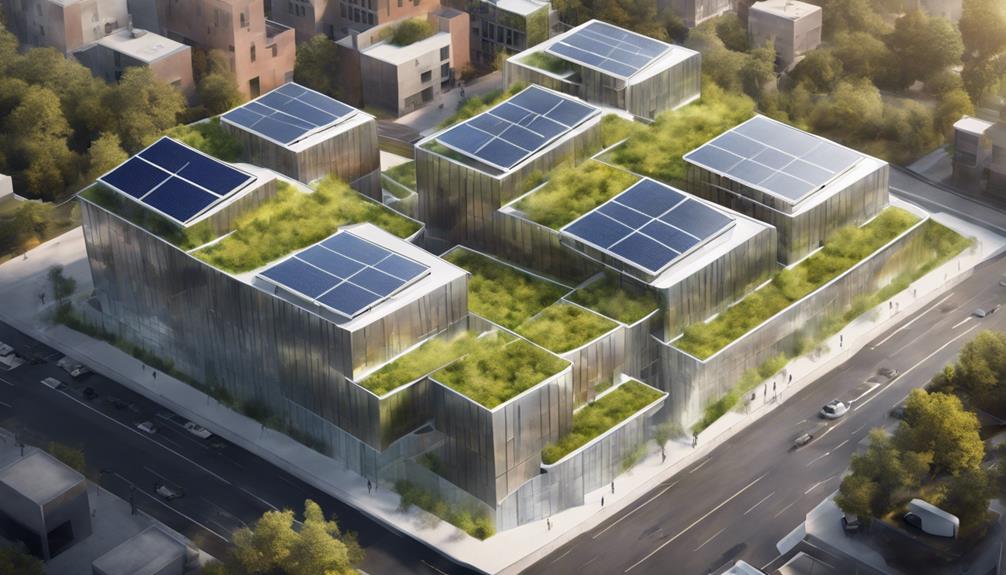Boost your building’s energy efficiency with virtual twins, a technology that revolutionizes operational strategies by integrating real-time monitoring and predictive modeling, thereby enhancing energy management efficiency and optimizing performance. By harmonizing data formats and standards through the integration of BIM and Digital Twins, you can guarantee seamless communication and realize significant cost savings. Virtual twins offer real-time insights and proactive maintenance, driving sustainable resource management and operational excellence. Discover how this cutting-edge technology can transform your building’s energy performance and operational success.
Digital Twins for Energy Efficiency
Digital twins for energy efficiency in buildings revolutionize operational strategies by enabling real-time synchronization and monitoring of energy systems for enhanced performance. These smart building technologies integrate physical replicas with digital models and communication channels to optimize energy management. By creating a virtual representation of the building and its energy systems, digital twins offer a holistic view that aids in operational decision-making.
Through the integration of digital twins with building operations, energy management becomes more efficient. These twins facilitate predictive maintenance and operational optimization by simulating various scenarios to identify energy-saving opportunities. By leveraging anomaly detection and predictive maintenance capabilities, digital twins enhance component monitoring, leading to significant improvements in energy efficiency within buildings.
In essence, digital twins serve as invaluable tools for enhancing energy management in buildings. They provide real-time insights, support proactive maintenance, and enable operators to make data-driven decisions for peak energy performance. Embracing digital twin technology is key to achieving sustainable and efficient energy usage in smart buildings.
Benefits of Virtual Twin Technology
Enhancing operational efficiency and sustainability in the construction industry, virtual twins offer a range of benefits that optimize planning, design, and energy consumption management. Virtual twin technology provides significant advantages that directly impact energy savings and environmental impact:
- Energy Efficiency: Virtual twins enable real-time planning simulations, allowing for data-driven decisions that lead to energy optimization in buildings. By fine-tuning various parameters virtually, energy consumption can be reduced, resulting in cost savings and environmental benefits.
- Circular Design: Virtual twins support circular design principles by facilitating material selection, procurement, and end-of-life sorting. This approach enhances sustainability efforts within construction projects, reducing waste and minimizing the environmental impact associated with traditional building practices.
- Collaboration and Iteration: Rapid design iteration and collaboration are enhanced through virtual twin technology. By visualizing and virtually testing different design scenarios, teams can efficiently work together to optimize building layouts and systems, ultimately leading to more energy-efficient and environmentally friendly structures.
Real-time Monitoring and Optimization

To advance beyond the benefits of virtual twin technology, real-time monitoring and optimization play a pivotal role in enhancing energy efficiency in buildings. Real-time monitoring with virtual twins allows for continuous data collection on energy consumption patterns, enabling optimization algorithms to analyze this data and identify inefficiencies while suggesting improvements. By integrating predictive modeling, virtual twins can simulate different scenarios to predict the impact of energy optimization strategies on building performance. The continuous optimization facilitated by virtual twins, along with the integration of IoT sensors and building management systems, enhances the accuracy of energy consumption analysis. Ultimately, the efficiency gains derived from virtual twins lead to cost savings, reduced environmental impact, and improved occupant comfort within buildings. Embracing real-time monitoring and optimization through virtual twins is essential for achieving significant improvements in energy efficiency and overall building performance.
Integration of BIM and Digital Twins
The integration of Building Information Modeling (BIM) and Digital Twins in facility management offers a sophisticated approach to enhancing energy efficiency and operational effectiveness. This fusion presents significant advantages but also comes with challenges that need to be addressed:
- Integration Challenges: Harmonizing the different data formats and standards between BIM and Digital Twins can be complex. Ensuring seamless communication and interoperability is essential for a successful integration.
- Data Accuracy: Maintaining precise and up-to-date data is vital for the accuracy of simulations within the digital twin. Any discrepancies between the physical building and its digital representation can lead to faulty analysis and ineffective optimization strategies.
- Simulation Accuracy and Performance Optimization: The accuracy of simulations within the digital twin directly impacts performance optimization initiatives. Leveraging the integrated BIM and Digital Twins allows for real-time monitoring and adjustments to enhance energy efficiency and operational effectiveness proactively.
Enhancing Building Performance

By incorporating smart sensor integration and predictive maintenance strategies, you can optimize building performance and enhance energy efficiency. These approaches allow for real-time monitoring and data-driven insights, enabling proactive measures to be implemented for improved operational outcomes. Through the utilization of such technologies, you can achieve significant cost savings and create a more sustainable environment within your building.
Smart Sensor Integration
Integrating smart sensors into building systems revolutionizes energy efficiency by providing real-time data on critical performance metrics and optimizing operations for enhanced building performance. Smart sensor integration offers a range of benefits:
- Predictive Analytics: Smart sensors enable the use of predictive analytics to forecast equipment failures or energy consumption spikes, allowing proactive maintenance and efficient resource allocation.
- Comprehensive Monitoring: These sensors track various parameters like temperature, humidity, occupancy, and energy usage, creating a detailed picture of building performance in real time.
- Optimized Operations: By leveraging a robust sensor network architecture, buildings can adjust settings dynamically based on data insights, ensuring energy efficiency and occupant comfort are maximized.
Predictive Maintenance Strategies
Enhancing building performance through predictive maintenance strategies involves leveraging digital twins and real-time sensor data to proactively identify and address potential issues. Predictive maintenance benefits from analyzing historical data and patterns, optimizing building operations, and preventing downtime. By integrating sensors with digital twins, accurate maintenance predictions enable efficient scheduling based on predictive analytics, improving overall efficiency and reducing costs. This approach leads to increased equipment lifespan and better energy optimization in buildings. Energy savings analysis is a vital aspect of predictive maintenance, allowing for proactive measures to be taken to guarantee ideal energy usage and cost-effectiveness.
| Predictive Maintenance Benefits | Energy Savings Analysis |
|---|---|
| Prevents downtime | Identifies energy waste |
| Optimizes building operations | Enables cost-effective solutions |
| Extends equipment lifespan | Improves energy efficiency |
| Reduces maintenance costs | Enhances overall building performance |
Case Studies and Industry Applications
When considering case studies and industry applications in boosting energy efficiency in buildings, it is crucial to examine real-world examples that showcase practical implementations. These instances offer insights into sector-specific benefits derived from technologies like virtual twins. By analyzing these cases, you can gain a better understanding of how cutting-edge solutions can be tailored to optimize energy usage and enhance building performance.
Real-World Examples
Real-world applications of virtual twins in the building sector have demonstrated tangible improvements in energy efficiency and operational performance. Here are three key examples showcasing the practical benefits:
- Predictive Maintenance: Virtual twins utilize predictive analytics to anticipate equipment failures, enabling proactive maintenance schedules that minimize downtime and energy wastage.
- Energy Consumption Monitoring: By integrating virtual twins with IoT sensors, buildings can continuously monitor energy consumption patterns, identifying opportunities for optimization and cost savings.
- Comfort Enhancement: Virtual twins simulate various scenarios to adjust heating, cooling, and lighting systems, ensuring ideal comfort levels for occupants while maximizing energy efficiency.
Practical Implementations
In the domain of practical implementations, case studies and industry applications vividly demonstrate the impact of virtual twins on optimizing energy efficiency in buildings. Building simulations facilitated by virtual twins provide insights into energy consumption patterns, allowing for informed decision-making to achieve significant energy savings. Through real-time monitoring and control capabilities, virtual twins enable proactive adjustments in energy systems, leading to enhanced operational efficiency. The utilization of virtual twins supports predictive maintenance strategies, which play a pivotal role in maintaining the best energy performance in building operations. By simulating alternative scenarios, virtual twins assist in identifying the most effective energy optimization strategies. Practical examples underscore how virtual twins drive cost reduction and operational efficiency in building management, showcasing their instrumental role in advancing energy efficiency.
Sector-Specific Benefits
Utilizing virtual twins in various sectors offers tailored benefits, including personalized treatment in healthcare, operational efficiency in smart manufacturing, and enhanced infrastructure management in urban planning.
- Personalized Healthcare: Virtual twins allow for individualized patient care by simulating medical conditions and treatments, aiding in diagnosis and personalized healthcare plans.
- Operational Efficiency in Smart Manufacturing: Virtual twins optimize production processes, predict maintenance needs, and enhance overall efficiency in manufacturing operations through real-time monitoring and simulation.
- Enhanced Infrastructure Management in Urban Planning: By utilizing virtual twins, urban planners can simulate and optimize infrastructure designs, predict maintenance requirements, and improve the overall management of city structures for sustainable development.



